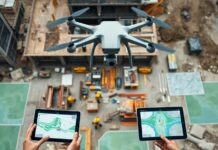The construction industry is facing a significant challenge when it comes to sustainability. It is responsible for producing more than 35% of the world’s human-caused CO2 emissions and also consuming 40% of the global raw materials. As nations and organisations around the world push themselves for net-zero emissions and municipalities present green building codes, construction firms are now placing a greater emphasis on enhancing their dedication to eco-friendly practices as well as decreasing waste.
Automation innovations have the potential to successfully address various sustainability challenges in numerous ways. The adoption of autonomous solutions has an advantageous effect on building efficiency by reducing the amount of time needed by onsite workers, thereby decreasing construction pollution.
One of the research projects has revealed that progressive construction firms, which are characterised by their use of four or more automated systems, are 58% more likely to achieve improvements in sustainability and waste reduction contrasted to their moderate counterparts.
According to one of the recent reports, 34% of construction leaders surveyed believe that sustainability will be their top business priority in the next three to five years. However, at present, sustainability is their lowest priority due to external factors such as macro headwinds. These factors have shifted their immediate focus to the supply chain, enhancing effectiveness, and dealing with shortages of labour.
In the current scenario, the construction industry has a unique chance to emerge as a global leader when it comes to sustainability. By demonstrating the benefits of investing in sustainability, even during an economic downturn, it can set a precedent for other sectors to follow. Today, in order to tackle the climate crisis, it is imperative that one incorporates autonomous technology into the construction of infrastructure, commercial buildings, as well as residential buildings. Below are three key ways in which one can go on to achieve this.
Empowering Sustainable Design
The notion that sustainable construction is a costly and impossible approach to guaranteeing a return on investment for a building is outdated and incorrect. Indeed, with the growing automation of green construction, the initial costs are being reduced, resulting in an earlier payback period. As stated by the U.S. Green Building Council, the upfront cost of constructing a green building is only 2%-3% higher in contrast to a typical building. However, the USGBC additionally points out that green buildings offer significant energy savings, leading to a 14% reduction in operational costs compared to traditional buildings.
By incorporating data from the beginning of a project, firms can improve their accuracy in calculating and taking off measurements. This prompts them to order only the essential materials, which decreases the amount of raw material that goes to waste. In addition, autonomy plays an important part in promoting sustainable design and construction by offering valuable insights that help prevent, recognise, as well as rectify wasteful practices, thereby reducing carbon footprints.
Using a digital twin to evaluate green buildings
By employing a modular construction process and incorporating a digital twin, which is essentially a computer-generated replica of a physical building, one can achieve the ability to evaluate and refine sustainable construction and operational procedures. Prefabricating components off-site in a controlled environment can be helpful in reducing CO2 emissions.
In addition, the utilisation of a digital twin in a project helps to minimise the need for rework by providing real-time insights.
ChatGPT is playing a significant role in operating the ongoing artificial intelligence (AI) revolution in the business world. In addition to that, AI is being combined with building sensors to offer immediate data, recommendations, and increased autonomy in managing building operations. This combination enables building operators to gain insights into the current condition of the structure they are monitoring. It helps them identify potential challenges and provides a platform for modelling and improving energy efficiency.
Revolutionising the process of dirt movement
Autonomous vehicles are rapidly advancing and will likely take over the roads in the near future. However, they are already being utilised on construction sites, contributing to more efficient building processes.
In the near future, one can expect to witness the emergence of autonomous and electric heavy construction vehicles, which will substantially decrease the industry’s dependence on fossil fuels.
The potential for autonomous robots in the construction industry extends well beyond just self-driving trucks, bulldozers, or excavators. Nowadays, one can witness the use of human-like robots or drones for autonomous data capture in construction projects. The machines scan the construction site on a daily basis and submit data to identify any areas of concern. This proactive approach allows for addressing issues promptly and minimising, or even eliminating, the need for future rework.
Assigning robots to repetitive tasks can enhance efficiency, allowing firms to complete projects more quickly. This, in turn, allows skilled labour to be allocated to other important tasks while also reducing the need for heavy equipment to remain onsite for extended periods. Ultimately, these measures contribute to a reduction in a project’s carbon footprint.
Nearly 38% of construction companies that utilise fully autonomous robotics have identified enhanced environmental sustainability as their primary advantage. This is closely tied to the capacity to minimise the resources required, deadlines, and budgetary concerns, which are frequently the most significant challenges in many projects. Construction firms can enhance their sustainability efforts and increase profitability by utilising autonomous technologies.



























